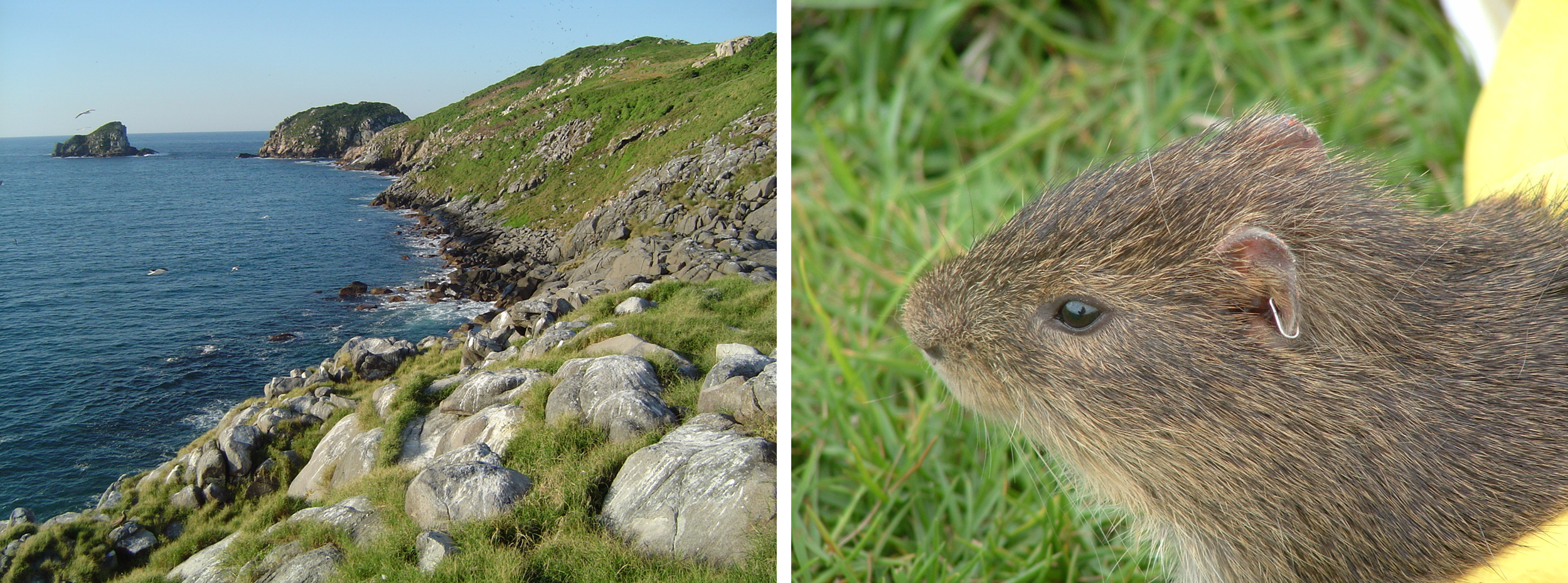


Santa Catarina’s Guinea Pig (Cavia intermedia) has the smallest geographical distribution of any known mammal. It occurs on a 10-ha island within the coastal archipelago of Moleques do Sul in Santa Catarina State, Brazil. This small, scrubby island is home to a few handfuls of guinea pigs, and has been for thousands of years.
It is thought most likely that Santa Catarina’s Guinea Pig descended from another guinea pig, C. magna, inhabiting the nearby Santa Catarina coastline. The guinea pigs became isolated on Moleques do Sul probably when rising seas formed the archipelago some 8,000 years ago. Since then, relatively little has changed. The island hosts no significant predators, competitors or humans, and its supply of food for herbivores is plentiful – a perfect scenario for the guinea pigs.
Over time, characteristics of this species have been shaped by island conditions in a phenomenon termed “island syndrome”. Santa Catarina’s Guinea Pigs have high survival rates, small home ranges and slow reproductive processes relative to that of similar continental species. Consequently, their population is small in number; surveys undertaken in 2004-2005 suggested that the island was inhabited by less than 50 individuals which qualified the guinea pigs for Critically Endangered status on the IUCN Red List. The IUCN later cited them in a list of the 100 most threatened species on the planet.
Despite their small numbers, the Santa Catarina’s Guinea Pig population might in fact be considered stable – it is highly possible that numbers have remained unchanged for centuries. Such a small population, nevertheless, is extremely vulnerable to chance events that could have a critical impact on the species. Insular rodent populations in the past have fallen victim to pathogen introduction or rising sea levels. For the guinea pigs, additional threats include fire, poaching and general human disturbance; the island is sometimes accessed illegally by fishermen who station themselves there overnight.
Surveying and safeguarding island guinea pigs

Camera on Moleques do Sul
Santa Catarina’s Guinea Pigs have scarcely been studied. They were discovered only a few decades ago and, since then, any effort to monitor them has been made difficult by the limited accessibility to the archipelago. One researcher, however, is committed to conserving this species.
Brazilian biologist Dr Carlos Henrique Salvador is the Small Mammal Specialist Group’s Key Species Champion for Santa Catarina’s Guinea Pig. Carlos led the initial project to survey the guinea pigs in 2004-2005 and is today working on monitoring the current population using a network of trail and security cameras, which were kindly funded by a Greensboro Science Center (GSC) grant. After testing the sampling design, the data gathered will ultimately be used to investigate things such as population size and feeding areas.

Captured by a Greensboro Science Center-funded camera trap
“The general goals are to monitor the species remotely, its habitat, and illegal use of the island by humans,” explained Carlos. “We have over 1 terabyte of images to process from the first sampling period. However, the island conditions make it difficult for deploying and running electronic devices, and adjustments will need to be made for future sampling rounds.”
In recent years, Carlos and his colleagues have also published a species action plan for Santa Catarina’s Guinea Pigs. The action plan focuses on increasing monitoring efforts – which have of course been initiated – and also deals with how to protect the island from illegal use whilst raising more awareness of this species.
It is hoped that such conservation and monitoring efforts will be enough to keep the population safe and stable. Although it may be the rarest rodent in the world, Carlos says “I am optimist, and I believe we can mitigate the risks posed to Santa Catarina’s Guinea Pigs.”
Check out some of the footage captured on one of Carlos’ GSC camera traps below!
Author: Abi Gazzard (SMSG Programme Officer)
Images & video: Carlos Henrique Salvador & Tabuleiro Institute





